Neuronal and glial apoptosis after traumatic spinal cord injury
- PMID: 9204923
- PMCID: PMC6793816
- DOI: 10.1523/JNEUROSCI.17-14-05395.1997
Neuronal and glial apoptosis after traumatic spinal cord injury
Abstract
Cell death was examined by studying the spinal cords of rats subjected to traumatic insults of mild to moderate severity. Within minutes after mild weight drop impact (a 10 gm weight falling 6.25 mm), neurons in the immediate impact area showed a loss of cytoplasmic Nissl substances. Over the next 7 d, this lesion area expanded and cavitated. Terminal deoxynucleotidyl transferase (TdT)-mediated deoxyuridine triphosphate-biotin nick end labeling (TUNEL)-positive neurons were noted primarily restricted to the gross lesion area 4-24 hr after injury, with a maximum presence at 8 hr after injury. TUNEL-positive glia were present at all stages studied between 4 hr and 14 d, with a maximum presence within the lesion area 24 hr after injury. However 7 d after injury, a second wave of TUNEL-positive glial cells was noted in the white matter peripheral to the lesion and extending at least several millimeters away from the lesion center. The suggestion of apoptosis was supported by electron microscopy, as well as by nuclear staining with Hoechst 33342 dye, and by examination of DNA prepared from the lesion site. Furthermore, repeated intraperitoneal injections of cycloheximide, beginning immediately after a 12.5 mm weight drop insult, produced a substantial reduction in histological evidence of cord damage and in motor dysfunction assessed 4 weeks later. Present data support the hypothesis that apoptosis dependent on active protein synthesis contributes to the neuronal and glial cell death, as well as to the neurological dysfunction, induced by mild-to-moderate severity traumatic insults to the rat spinal cord.
Figures


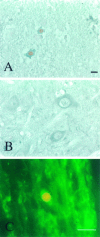


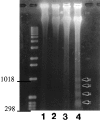

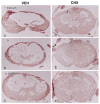
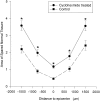

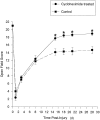
References
-
- Allen AR. Remarks on the histopathological changes in the spinal cord due to impact. An experimental study. J Nerv Ment Dis. 1914;41:141–147.
-
- Arends MJ, Wyllie AH. Apoptosis: mechanisms and roles in pathology. Int Rev Exp Pathol. 1991;32:223–254. - PubMed
-
- Balentine JD. Pathology of experimental spinal cord trauma. I. The necrotic lesion as a function of vascular injury. Lab Invest. 1978a;39:236–253. - PubMed
-
- Balentine JD. Pathology of experimental spinal cord trauma. II. Ultrastructure of axons and myelin. Lab Invest. 1978b;39:254–266. - PubMed
-
- Barres BA, Jacobson MD, Schmid R, Sendtner M, Raff MC. Does oligodendrocyte survival depend on axons? Curr Biol. 1993;3:489–497. - PubMed
Publication types
MeSH terms
Grants and funding
LinkOut - more resources
Full Text Sources
Other Literature Sources
Medical
